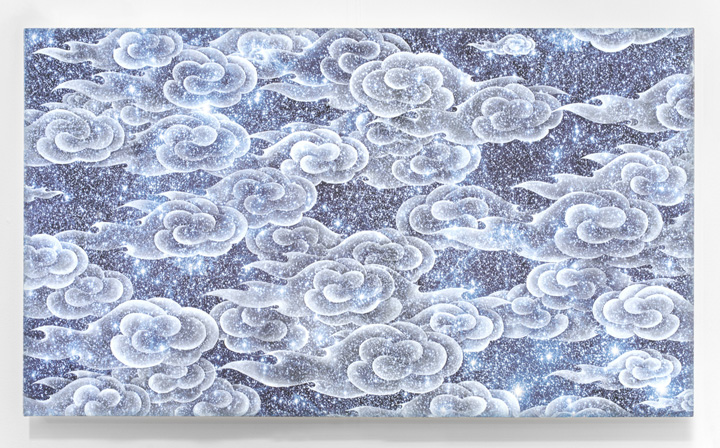Ala Ebtekar, “Parallax”
Gallery Paule Anglim
14 Geary Street, San Francisco, CA 94108
April 23–May 31, 2014
By Leora Lutz

Ala Ebtekar, “Zenith,” 2014. Acrylic on archival pigment print on canvas,
42” x 74”. Courtesy of Gallery Paule Anglim.
Two works are mounted across from each other in direct conversation. Seemingly disparate, the two are not visually similar, but conceptually related. Each piece remarks on an altered view, as the definition of the exhibition title “Parallax” suggests. And each piece subliminally remarks on Ebtekar’s polarized identity as a Persian American. Drawing visual references from both cultures, Ebtekar comprises these works that together create a dialog with the unknown.
The painting, “Zenith,” is mounted on the wall facing the entrance of the small gallery. The painting depicts a celestial field of milky, stylized clouds on a midnight-blue ground peppered with stars. As with Ebtekar’s work in general, the piece is signature of his use of Persian folkloric symbology derived from ancient texts, specifically the poetry of Hafez. Circa 1300 C.E., a line from Hafez’s “Ghazal 317” reads: “Fell in the trap of life and worldly tragedy. I was an angel, I resided in the heavens; Renovation of the world – the mission given to me.” In this text the author embarks on a metaphorical journey with the cosmos, and so is the case with Ebtekar’s work in this exhibition.

Ala Ebtekar, “Fantastic Voyage,” 2014. Acrylic on archival pigment print on found poster, light box, 41 1/2” h x 27 1/2” w x 2 3/4” d (light box off). Courtesy of Gallery Paule Anglim.
Directly opposite is “Fantastic Voyage,” an embellished vintage movie poster of the same name mounted on a light box. The perimeter of the poster is accented with illustrative motifs that are exemplary of detailed classical Persian designs used in architecture and clothing as well as illuminated texts. The piece references East meets West, combining pop culture with ancient decoration to emphasize the tension between the superfluous and the transcendent. In the center is a detailed, scallop-edged space insinuating a window, which Ebtekar refers to as symbolic of portals. Within the portal, the dark blue universe expands in the distance behind the filigree window pane. Curiously, when the light in the light box is illuminated, the entire imagery of the universe virtually disappears, and the window pane is now a silhouette of darker reddish tones. An orange-hued scene of a larger-than-life peering eye “cries” humans cascading in the foreground. The text of the movie poster is also revealed when lit, but in reverse, strangely referential to backward masking. The entire mood of the piece shifts from a dream state to that of foreboding and illegible uncertain doom.

Ala Ebtekar, “Fantastic Voyage,” 2014. Acrylic on archival pigment print on found poster, light box, 41 1/2” h x 27 1/2” w x 2 3/4” d (light box on). Courtesy of Gallery Paule Anglim.
When the light box is turned off, the two works in the show complement each other—but when the light is on, the contrast between the two is a striking metaphor for day and night, for life and death. In looking at the Hafez quote again, one must reflect on the mission of the role of the artist and his role as a renovator, residing in the universe, grappling with the existential trappings of life and worldly tragedies. Somewhere in that mire, Ebtekar makes works that are contemplative and mystic while at the same time very grounded.
For more information about the show, visit Gallery Paule Anglim.
Previous contributions by Leora Lutz include:
Review: Art Market San Francisco
Review: Clare Rojas, “Caerulea” at Gallery Paule Anglim, San Francisco
Review: “Surround Sound” solo exhibition by Ben Barretto at Highlight Gallery, San Francisco



